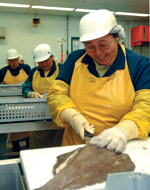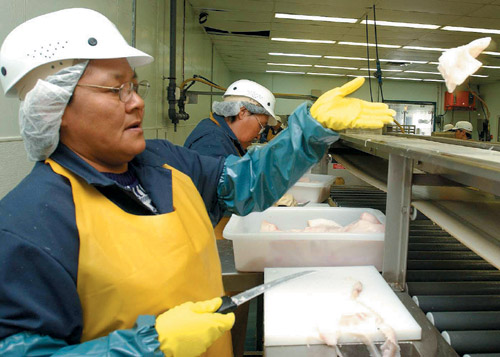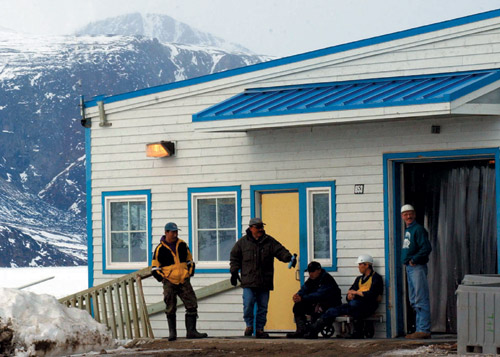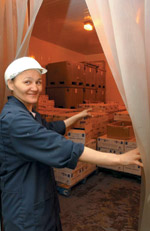|
 PANGNIRTUNG
- Geela Evic slips into a yellow apron and disappears into the Pangnirtung
Fisheries Inc. plant. The factory rumbles with conveyor belts and forklifts. PANGNIRTUNG
- Geela Evic slips into a yellow apron and disappears into the Pangnirtung
Fisheries Inc. plant. The factory rumbles with conveyor belts and forklifts.
Evic
joins 35 other rubber-gloved employees processing the final 225,000 kilograms
of turbot hauled from Cumberland Sound this winter.
The
year's inshore fishery netted triple the size of last year's 76,500 kilogram
catch.
"It's
a very promising sign," says Michael Nowinski, the plant's general
manager.
The
results are good news for Pangnirtung, the only Nunavut community using
high-volume ice fishing for commercial purposes. The fishery employs more
than 80 people: 50 plant workers and 35 fishermen annually. More jobs
are expected in the coming year.
The
number of fish from Cumberland Sound's inshore fishery has risen, fallen
and is rising again, according to data collected by the federal department
of fisheries and oceans.
Last
year, the Pangnirtung fish plant processed 450,000 kilograms, of fish,
most of it turbot, from the combined inshore and offshore fisheries along
Baffin Island's east coast. A small portion of char is processed at the
plant each summer.
 Nowinski
says 99 per cent of their product goes to U.S. markets. The remaining
one per cent is shipped to Nunavut restaurants and Iqaluit Enterprises,
Baffin Island's only privately owned commercial fish store and meat processing
plant. Nowinski
says 99 per cent of their product goes to U.S. markets. The remaining
one per cent is shipped to Nunavut restaurants and Iqaluit Enterprises,
Baffin Island's only privately owned commercial fish store and meat processing
plant.
Nowinski
is encouraged by this year's inshore numbers. So much so he's adding additional
freezer space and filleting equipment this summer.
A
greater volume of fish means increased employment opportunities, he predicts.
"We're
gong to see more jobs, not less," Newinski says.
The
past and the future
Inshore
turbot fishing in Cumberland Sound began 1987, after hunters reported
finding the deep-water fish in the stomachs of seals. Until then, turbot
sightings were rare or not reported.
 Longlining
was introduced and is still used today about 100 kilometres from town.
The basic ice-fishing technique involves lowering a line with 100 baited
hooks through a hole the ice. The lines lie 300 to 500 metres deep and
are weighted with a kite and anchor. A motorized hauler pulls the lines
up. Longlining
was introduced and is still used today about 100 kilometres from town.
The basic ice-fishing technique involves lowering a line with 100 baited
hooks through a hole the ice. The lines lie 300 to 500 metres deep and
are weighted with a kite and anchor. A motorized hauler pulls the lines
up.
Inshore
catch rates peaked in 1993 with a total harvest of 420,000 kilograms during
an 18-week fishery. Six years later, the numbers plummeted to a meager
34,000 kilograms from an 11-week fishery. The decline was a reflection
of fisherman not fishing as long or as much because of thin, cracked ice
battered by wind.
Inshore
turbot fishing has money-making potential because the demand for fish
is high and equipment costs are low. Unlike offshore fishing in Baffin
Bay and Davis Strait, inshore fishing does not need million-dollar boats,
specially trained equipment operators or a deep-sea-port - resources Nunavut
stakeholders insist they want but can't afford.
Instead,
hunters have the basic inshore equipment: snowmobiles and qamutiit.
 Plans
are under way to develop Nunavut's emerging turbot fishery both inshore
and offshore. The Nunavut Fisheries Working Group (NFWG) is made up of
Nunavut's department of sustainable development, Nunavut Tunngavik Inc.
and the Nunavut Wildlife Management Board. Plans
are under way to develop Nunavut's emerging turbot fishery both inshore
and offshore. The Nunavut Fisheries Working Group (NFWG) is made up of
Nunavut's department of sustainable development, Nunavut Tunngavik Inc.
and the Nunavut Wildlife Management Board.
Currently,
the group's focus has been on turbot and shrimp. However, crab, scallops,
clams and mussels in various east coast hamlets are also being explored.
NFWG
wants a separate management zone for Cumberland Sound. Right now, the
fiord is part of Zone OB in Davis Strait and subject to fishing by outside
interests for various and contentious reasons currently under review.
NFWG
wants DFO to approve a separate annual one million kilogram turbot quota
specifically for Cumberland Sound.
"This
quota would permit and promote the further development of the winter fishery
as well as provide opportunities to explore the development of an open-water
summer fishery," an NFWG report says.
The
application is currently before DFO.
Good
news, bad news
Cumberland
Sound is known for its high winds that create unstable ice and prevent
fishermen from safely reaching their longlining holes. This year was different.
"The
ice conditions are the best we've seen in seven years," said Robert
Fiander, the plant's production manager.
 However,
the bounty is bittersweet. The delicate white fish is trading at $2 less
per pound than it was two months ago. The shortfall is due to human disease,
a strong Canadian dollar and a surplus of turbot. However,
the bounty is bittersweet. The delicate white fish is trading at $2 less
per pound than it was two months ago. The shortfall is due to human disease,
a strong Canadian dollar and a surplus of turbot.
Recent
SARS (Severe Acute Respiratory Syndrome) cases worldwide affected some
the biggest turbot purchasers.
"Nobody
is going out to Asian restaurants," Fiander says.
Secondly,
a strong Canadian dollar means U.S. brokers – who purchase the majority
of Nunavut's turbot and char with U.S. dollars – are paying less
per pound because the U.S. dollar is worth less relative to the Canadian
dollar than it was two months ago.
And
finally, as is the case every year, turbot season in Atlantic Canada opened
this month. The additional fishing creates flooded market, and prices
inevitably drop.
Even
so, Fiander is cautiously optimistic. He sees growth potential but is
concerned about capacity building.
"If
the volume of fish doubles, we'd have to get our own plane to keep the
fish moving out," he says.
|


![]()
 PANGNIRTUNG
- Geela Evic slips into a yellow apron and disappears into the Pangnirtung
Fisheries Inc. plant. The factory rumbles with conveyor belts and forklifts.
PANGNIRTUNG
- Geela Evic slips into a yellow apron and disappears into the Pangnirtung
Fisheries Inc. plant. The factory rumbles with conveyor belts and forklifts.
 Nowinski
says 99 per cent of their product goes to U.S. markets. The remaining
one per cent is shipped to Nunavut restaurants and Iqaluit Enterprises,
Baffin Island's only privately owned commercial fish store and meat processing
plant.
Nowinski
says 99 per cent of their product goes to U.S. markets. The remaining
one per cent is shipped to Nunavut restaurants and Iqaluit Enterprises,
Baffin Island's only privately owned commercial fish store and meat processing
plant. Longlining
was introduced and is still used today about 100 kilometres from town.
The basic ice-fishing technique involves lowering a line with 100 baited
hooks through a hole the ice. The lines lie 300 to 500 metres deep and
are weighted with a kite and anchor. A motorized hauler pulls the lines
up.
Longlining
was introduced and is still used today about 100 kilometres from town.
The basic ice-fishing technique involves lowering a line with 100 baited
hooks through a hole the ice. The lines lie 300 to 500 metres deep and
are weighted with a kite and anchor. A motorized hauler pulls the lines
up. Plans
are under way to develop Nunavut's emerging turbot fishery both inshore
and offshore. The Nunavut Fisheries Working Group (NFWG) is made up of
Nunavut's department of sustainable development, Nunavut Tunngavik Inc.
and the Nunavut Wildlife Management Board.
Plans
are under way to develop Nunavut's emerging turbot fishery both inshore
and offshore. The Nunavut Fisheries Working Group (NFWG) is made up of
Nunavut's department of sustainable development, Nunavut Tunngavik Inc.
and the Nunavut Wildlife Management Board. However,
the bounty is bittersweet. The delicate white fish is trading at $2 less
per pound than it was two months ago. The shortfall is due to human disease,
a strong Canadian dollar and a surplus of turbot.
However,
the bounty is bittersweet. The delicate white fish is trading at $2 less
per pound than it was two months ago. The shortfall is due to human disease,
a strong Canadian dollar and a surplus of turbot.